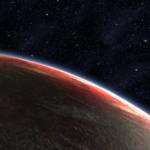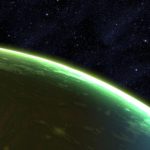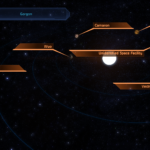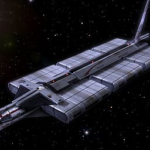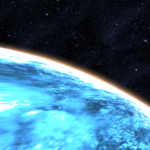System Specs:
- Stellar Mass: 17.834 Sol Masses
- Stellar Class: B0
- Luminosity: 20,000 Sol
- Planets: 5
- Moons: 0
- Asteroid Belts: 0
- Asteroids: 0
- Objects: 1
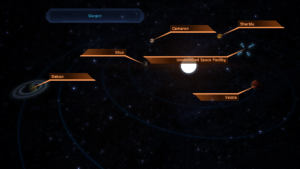
The system is named after the gorgons of Greek mythology. Medusa, who was slain by Perseus, is the best known of the three named gorgons. The ancient stories speak of Medusa transforming men into stone when they gazed directly at her. This is reminiscent of how the tidally-locked planets of the system, Wuo and Camaron, have the side that is facing Gorgon perpetually scorched, with the opposite side being completely frozen, thus making colonization impractical at best. Gorgon is classified as a B-type star.
–
Planets Directory:
- Wuo
- Vectra
- Unidentified Space Facility (USF) UNC: Depot Sigma-23
- Camaron
- Sharblu
- Slekon
–
Wuo:
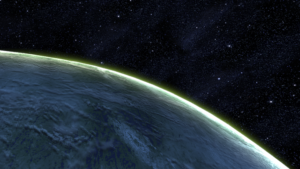
- Orbital Distance: 76.4 AU
- Orbital Period: 158.0 Earth-years
- Keplerian Ratio: 17.863
- Radius: 6,959 km
- Day Length: 158.0 Earth-hours
- Atmospheric Pressure: 0.44 atm
- Surface Temp: 1,157 °C
- Surface Gravity: 0.66 g
- Mass: 0.78 Earth-masses
Wuo is a terrestrial planet only known from scan data picked up by unmanned probes. Though over 76 AU from the blue giant Gorgon, temperatures in Wuo’s orbit are still dangerously high. Only ships with very powerful heat radiating systems can venture that deep into the system.
Fortunately, Wuo is not a terribly interesting world. It has a thin atmosphere of nitrogen and methane, and the scorching surface is mainly composed of alumina with deposits of platinum. The world is tidally locked to Gorgon, leaving the sunward side a scorched and irradiated wasteland, and the dark side frigid and ice-crusted.
–
Vectra:

- Orbital Distance: 99.45 AU
- Orbital Period: 234.7 Earth-years
- Keplerian Ratio: 17.856
- Radius: 69,833 km
- Day Length: 234.7 Earth-years
- Atmospheric Pressure: _ atm
- Surface Temp: _ °C
- Surface Gravity: _ g
- Mass: _ Earth-masses
Vectra is a typical hydrogen-helium gas giant with traces of methane and sodium in its atmosphere. The heat of the star Gorgon is slowly blasting away the gas giant’s massive atmosphere, which is visible as a long, dim tail that trails behind the planet.
–
Unidentified Space Facility (USF) UNC: Depot Sigma-23
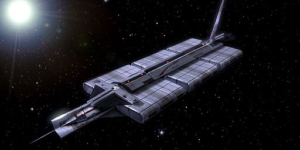
The data you found at Listening Post Theta indicates that a supply ship came from Depot Sigma-23 in the Gorgon system just before the attacks on Listening Posts Alpha and Theta. That supply depot is likely where this rachni infestation originated.
Acquisition
This assignment is acquired from a terminal on Altahe or from Lt. Durand on Nepmos. However, both prerequisite assignments must be completed to get the facility’s location.
If Listening Post Theta is done first instead of Listening Post Alpha, this assignment’s journal entry may be obtained just before exiting the station.
Preparation
This assignment involves fighting a lot of rachni in a cluttered freighter environment, so powers such as Neural Shock, Throw and Lift are quite useful. Shields on the other hand will be useless, as will talents intended to overheat shields and weapons. Damage prevention and toxic resistance armor mods will come in handy, as will Shredder, Hammerhead, and Sledgehammer rounds.
Walkthrough
After learning that the rachni appeared after an automated supply delivery, travel to the Gorgon system in the Argos Rho cluster and board the Unidentified Space Facility. The entryway is clear of enemies, of anything for that matter. The rachni that are aboard are waiting for you and your squad, so it would be rude to keep them waiting.
The main hold of the ship contains seven Rachni Workers, and one solitary Rachni Soldier. Once you enter the hold take a left because that is where the soldier is. Take it out first because it is the greatest threat, then turn around to combat the workers. Once the workers are down turn around and hack the two weapons lockers (one requiring Easy Decryption, the other requiring Hard Decryption) in the area where the soldier was. Then proceed to the forward section of the ship.
On your way to the forward section of the ship be on the lookout for more containers on the way. In this order from the entrance door to the forward section: a secure crate requiring Average Decryption; be careful because this is easy to miss. Then a wetware kit is hidden in an alcove. A technician kit, this is another easy one to miss. Just before the door to the forward section is another locked crate, which requires Easy Decryption. Before going through the door, move around the corner and pick up an upgrade kit.
Entering the forward section of the ship head to the right first because this room contains containers that you will miss when you activate the charges. The room contains a medical station (Easy Decryption required), a crate, 2 storage lockers (one requiring Easy Decryption, the other requiring Average Decryption), and an upgrade kit. The cockpit contains nothing, so it is worth passing up. Try to remember this route because you will be making your way back, and in a hurry.
In the left module, you’ll find a terminal with data logs by Major Elena Flores. Listen to the logs to get an idea of what happened here:
- The first log entry describes that the station is operational. The log says that they will be adding the barracks and stocking munitions. Flores says that they will have room for two reinforced platoons of Cerberus Commandos.
- The second entry describes the package arriving and how these ones are supposed to be different. Something about developing in proximity to the master control unit. Flores documents a plan to ‘test’ the rachni by unleashing them on some local pirates.
- The third entry describes that the rachni have escaped, accessing the freighters and setting them to random destinations. It goes on to tell how the Cerberus personnel “treated them like animals. We should have treated them like POWs.” Flores tells someone called the General, to “screw the rachni” and destroy the station.
Now that is what you will do. Next to the terminal are some demo charges. Be warned that once you access it you will have only 01:10 or 70 seconds to get back to the Normandy. Before you set off the charges make sure you have all the goodies that are spread all over the station. When you are ready set the charges, now all you have to do is RUN.
More rachni will spawn the second you arm the scram charges and attempt to block your access back to the Normandy. Five Rachni Workers and a Rachni Soldier will be waiting outside the door from the forward section to the main hold to block access. Send in your squadmates first then follow. Take out the rachni fast then double-time it to the Normandy. Once you reach the Normandy leave because every second that you wait at the airlock is another second off the clock. THE CLOCK DOES NOT STOP. Once you leave you will complete the assignment.
Note: The cargo hold layout is exactly the same as the layout of the MSV Cornucopia in the assignment UNC: Derelict Freighter.
(planet album)
–
Camaron:

- Orbital Distance: 199.0 AU
- Orbital Period: 664.8 Earth-years
- Keplerian Ratio: 17.831
- Radius: 5,198 km
- Day Length: 664.8 Earth-years
- Atmospheric Pressure: 0.23 atm
- Surface Temp: 747 °C
- Surface Gravity: 0.55 g
- Mass: 0.363 Earth-masses
Camaron is a terrestrial world with a thin atmosphere of carbon dioxide and argon. The surface is scorching hot, primarily composed of iron with deposits of nickel. Like Wuo, Camaron is tide-locked to the blue giant, forever “looking into the face of the Gorgon“.
–
Sharblu:
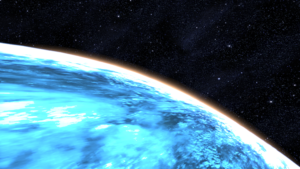
- Orbital Distance: 373.63 AU
- Orbital Period: 1,711.0 Earth-years
- Keplerian Ratio: 17.817
- Radius: 43,342 km
- Day Length: 1,711.0 Earth-hours
- Atmospheric Pressure: _ atm
- Surface Temp: _ °C
- Surface Gravity: _ g
- Mass: _ Earth-masses
A standard hydrogen-helium gas giant, the methane in Sharblu‘s atmosphere gives it an azure hue.
The asari crew who initially surveyed the system (during Earth‘s 17th century) named Sharblu after a then-popular soprano. The singer was renowned for her unusual skin tone, which was quite similar to that of the planet.
Properties
Sharblu is too small to be a “standard hydrogen-helium gas giant” (William Hubbard, The New Solar System 4th ed, 1999; p. 194). In addition its 17.8 sol-mass star cannot have formed before 7.48 million years ago. It is too hot to attract ices. It is more likely a super-terrestrial proto-planet. The clear gasses in its atmosphere will suffice to induce a Rayleigh scattering effect and an appearance of deep blue (with clouds).
(planet album)
–
Slekon:
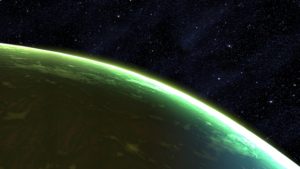
- Orbital Distance: 709.9 AU
- Orbital Period: 4,483.1 Earth-years
- Keplerian Ratio: 17.801
- Radius: 77,115 km
- Day Length: 4,483.1 Earth-years
- Atmospheric Pressure: _ atm
- Surface Temp: _ °C
- Surface Gravity: _ g
- Mass: _ Earth-masses
Orbiting at an unbelievable distance of 710 AU (over 66 billion kilometers) from Gorgon, Slekon is a huge gas giant, with an atmosphere tainted by methane and chlorine.
Properties
Its 17.8 sol-mass star cannot have formed before 7.48 million years ago. At that age, Jupiter had a radius upward of 100,000 km.
Slekon is more likely a young Neptune in mass.
–
–




